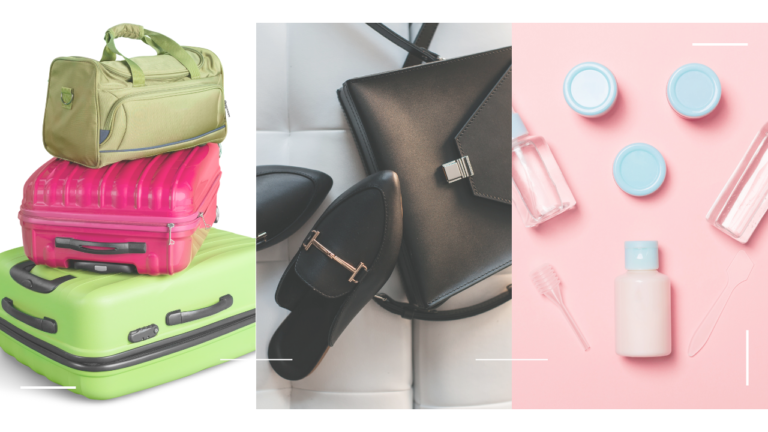A Traveler’s Guide to Less Luggage, More Freedom
How to Pack Light
Packing light can be a game-changer, allowing you to travel more freely and with less hassle. Here are some tried-and-true tips to help you master the art of packing only what you need.
1. Choose the Right Bag
- Use a carry-on: A smaller bag will naturally limit how much you pack, helping you prioritize essentials.
- Opt for a backpack or a compact suitcase: A lightweight, versatile bag that’s easy to carry can make all the difference.
2. Plan Outfits Ahead
- Mix and match: Choose neutral colors or a capsule wardrobe that allows you to pair items in different ways. Three tops and two bottoms, for example, can create six unique outfits.
- Consider the weather: Check the forecast and pack accordingly, bringing items that can be layered for cooler temperatures or worn alone in warmer climates.
3. Limit Shoes
- Bring two pairs, max: One comfortable walking shoe and one versatile pair for evenings or special occasions. Shoes take up a lot of space, so limiting pairs keeps your bag lighter.
- Wear your heaviest shoes during travel: This leaves more room in your bag and reduces the load you carry.
4. Roll Your Clothes
- Rolling clothes instead of folding them saves space and minimizes wrinkles. This technique is especially useful for thinner fabrics and smaller items like t-shirts, dresses, and pants.
5. Use Packing Cubes
- Packing cubes organize and compress your clothes, making it easy to find what you need without unpacking everything. Group clothes by type, like tops in one cube and bottoms in another, for added convenience.
6. Stick to Travel-Sized Toiletries
- Opt for travel-sized versions of your toiletries or use refillable bottles. Remember, many accommodations offer basics like shampoo and conditioner, so only pack what you can’t live without.
7. Bring Multi-Use Items
- Choose items that serve multiple purposes, like a scarf that can double as a blanket, a dress-up or down jacket, and quick-dry clothes that you can wash on the go.
8. Limit Tech and Gadgets
- Bring only essential electronics. A smartphone can serve as a camera, GPS, and entertainment source, minimizing the need for multiple devices. Also, pack a universal power adapter if you’re traveling internationally.
9. Create a Packing Checklist
- Make a list of essentials a few days before your trip and stick to it. A checklist prevents last-minute overpacking and ensures you don’t forget anything important.
10. Be Selective with Accessories
- Pack minimal jewelry and accessories, as these can easily get lost or tangled. Opt for versatile, lightweight pieces that complement your outfits.
By following these steps, you’ll enjoy a stress-free packing experience that keeps you mobile, organized, and able to adapt to any adventure. Pack light, travel far!
10-Step Travel Safety Checklist for Solo Travelers
Traveling solo is an empowering and exciting experience — but your safety should always come first. Use this essential checklist to help you stay secure and enjoy every moment of your solo adventure!
✅ 1. Research Your Destination Thoroughly
Learn about local customs, laws, cultural norms, and areas to avoid.
Check government travel advisories and recent traveler reviews.
✅ 2. Share Your Itinerary with Someone You Trust
Send a copy of your travel plans to a friend or family member.
Include hotel info, flight details, and local emergency contacts.
✅ 3. Book Accommodations with Safety in Mind
Choose places with good reviews, secure entrances, and a 24-hour front desk.
Avoid isolated or poorly lit locations.
✅ 4. Secure Travel Insurance
Get coverage for medical emergencies, theft, trip cancellations, and delays.
Always carry a digital and physical copy of your policy.
✅ 5. Make Digital & Physical Copies of Important Documents
Passport, ID, visa, credit cards — keep one copy with you and one in your email/cloud.
✅ 6. Pack Smart for Safety
Carry a whistle, small flashlight, door stopper, and personal safety alarm.
Keep emergency contact info in your wallet and on your phone lock screen.
✅ 7. Stay Connected
Use local SIM cards or eSIMs to have internet access anytime.
Check in daily with someone back home.
✅ 8. Avoid Oversharing on Social Media
Post your travel photos after leaving each location to protect your real-time whereabouts.
✅ 9. Trust Your Gut & Stay Aware
If something feels off, don’t ignore it.
Avoid walking alone at night or accepting rides from strangers.
✅ 10. Learn Basic Phrases & Emergency Numbers
Know how to ask for help in the local language.
Memorize or write down emergency numbers like police, ambulance, and embassy.
✨Tip: Register with your country’s embassy when traveling abroad — they can assist in emergencies and keep you updated on safety alerts.

Each new experience broadens your knowledge and contributes to your personal development, leaving you with memories that last a lifetime.
Navigating unfamiliar environments builds confidence and adaptability, skills useful in all areas of life.

